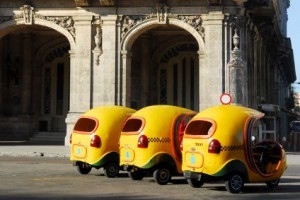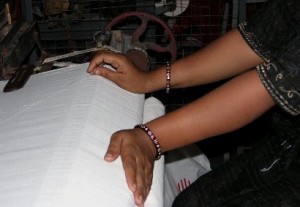 This article is the second of a series of two that makes a case for why small fashion SMEs may be a thought leader for large fashion companies on how to tackle environmental sustainability. The first part set the scene and presented 2 community initiatives based. This second part presents 2 further case studies: one based on a co-operative model, and one following the ‘traditional’ designer driven studio approach.
This article is the second of a series of two that makes a case for why small fashion SMEs may be a thought leader for large fashion companies on how to tackle environmental sustainability. The first part set the scene and presented 2 community initiatives based. This second part presents 2 further case studies: one based on a co-operative model, and one following the ‘traditional’ designer driven studio approach.
Previously: Community initiatives case study: Assisi Garments & Sawang Boran
Conglomerate of regional co-operatives case study: MORALFIBRE

Khadi is inherently carbon neutral as the production process is chiefly based on manual labour. MORALFIBRE takes this concept one step further: while promoting a ‘Cradle to Cradle’ ideology, the company acts as commercial umbrella for Khadi co-operatives within a 300km radius, and thereby influences over 5000 weavers’ households. They support the co-operatives in gaining international relevant certifications where feasible – e.g. OecoTex or GOTS – and make environmental sustainability a top priority in their supply chain: They are developing all processes of cloth making, dyeing and processing, entirely free of chemicals that are harmful to the environment.
They company is planning to set up an R&D centre and design studio to improve and develop the existing hand-spinning and weaving tools and techniques, as well as the respective industrially accredited testing methods. All with the goal to create superior quality standardised grades of fabrics based on the environmentally sustainable Khadi tradition.
Designer collaboration case study: Shazia Saleem & House of Tammam
The two UK-India based designer brands Shazia Saleem London and House of Tammam prove that couture can make a difference precisely because high-end fashion requires a tight control of every single step in the creation and manufacturing process.


In both cases, the environmental commitment becomes apparent even in the ‘unimportant’ details of how their business is run: from the use of vegetable ink on recycled paper printing for stationary and business cards, to the voluntary rejection of private or corporate car ownership.
Conclusion
Can the textile SME sector impact the high-volume manufacturing industry as far as environmental sustainability is concerned? In what way will that need to happen, and what can the ‘big’ ones learn from their smaller peers? And importantly: Can this knowledge be scaled up at all?
For that, let me take an example of Europe’s own textile history: St. Gallen, a small city in the East of Switzerland currently counting some 72’000 inhabitants, was until barely 100 years ago one of Europe’s principle textile production centres. What started off in the 11th century as a cottage linen industry, had by the early 17th century evolved into a city with some 4000 inhabitants and an industry output of 2.5 Mio. meters of linen cloth per year, mostly destined for export! The environment managed to cope with this high output of the local industry, not the least because in those days natural processes was all that was available: from the retting over the long winter months to the use of sunlight as natural bleaching agent in the summer.
What we can learn from this piece of history is that scale does not necessarily imply that highly effective, ecological but traditional processes and techniques need be abandoned, although it goes without saying that it has happened for the mere sake of convenience and simplicity. Modernized and sustainable varieties of traditional processes are no less convenient than the fully industrialised modern versions – provided that the necessary expertise exists.
And it is here that this topic goes full circle: SMEs, taken together as a group, have an immense negative environmental footprint since very few have the relevant skills or knowledge. They struggle to innovate their business, be it by following the latest technological developments, or by ‘going back, so as to go forward’.
Paradoxically, at the same time a tiny minority of small enterprises are true masters in their discipline, and run what is an environmentally fully sustainable business. Be it that their knowledge has been handed down over generations, or that sheer need and experimentation were the underlying reasons. This latter category has taken on a leadership position which should finally be acknowledged by the large industrial conglomerates. Talking of textile sustainability, it is here where the potential for innovation is much higher than any multi-national enterprise can afford to finance through their R&D departments.
—
This article is the second of a series of two that makes a case for why small fashion SMEs may be a thought leader for large fashion companies on how to tackle environmental sustainability. The first part set the scene and presented 2 community initiatives based. This second part presents 2 further case studies: one based on a co-operative model, and one following the ‘traditional’ designer driven studio approach.

